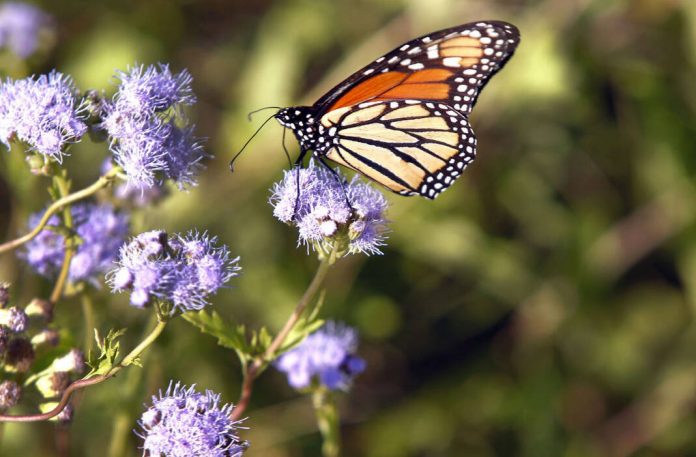
A monarch butterfly is seen during the Texas Butterfly Festival at the National Butterfly Center on Saturday, Nov. 4, 2017, in Mission. (Courtesy Photo)
News of the monarch butterfly now being an endangered species may have been slightly exaggerated, at least according to the local butterfly center director in the Rio Grande Valley.
On Thursday, news outlets across the country reported the monarch was now an “endangered” or a “threatened” species, citing a report by the International Union for the Conservation of Nature and Natural Resources.
The IUCN announced in a news release Thursday that the migratory monarch butterfly entered its Red List of Threatened Species as endangered, reporting a sharp decline in population between 22% and 72% in the last 10 years.
It blamed the threat of habitat destruction and climate change. Deforestation as well as legal and illegal logging have also contributed to the destruction of “substantial areas of the butterflies’ winter shelter in Mexico and California,” according to the IUCN.
Pesticides and herbicides also kill butterflies and milkweed, which IUCN said is the host plant monarch larvae feed on.
Marianna Treviño-Wright, however, says there’s more to the story.
The executive director of the National Butterfly Center, located in Mission, said the North American monarch butterfly is not endangered, nor has it been identified as such by any federal agencies that track wildlife populations.
“The monarch butterfly has not been listed as endangered in the United States or by U.S. Fish and Wildlife,” Treviño-Wright said, adding she fielded calls all day Thursday, which is when news of the IUCN endangered classification broke.
“… This (IUCN report) has zero bearing on monarch conservation efforts anywhere in the world. All it means is that the IUCN chose to add the monarch to their red list.
“They are not endangered anywhere. They are a globally secure species at this time,” she added.
To be clear, the IUCN explained in its report that it listed the migratory monarch butterfly, which is a subspecies of the monarch butterfly, as endangered and not the monarch species itself. The IUCN also pointed to conservation efforts optimistically.
“It is difficult to watch monarch butterflies and their extraordinary migration teeter on the edge of collapse, but there are signs of hope,” Anna Walker, a member of an IUCN specialist group specific to butterflies and moths, said in the release. “So many people and (organizations) have come together to try and protect this butterfly and its habitats.
“From planting native milkweed and reducing pesticide use to supporting the protection of overwintering sites and contributing to community science, we all have a role to play in making sure this iconic insect makes a full recovery.”
Outlets such as the Associated Press also stopped short of reporting the species was endangered definitively, and acknowledged that U.S. agencies haven’t listed the species which is in disagreement with other environmental groups.




